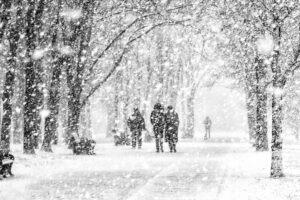
There’s a distinct difference between a blizzard and a snow squall. Where blizzards are long-lasting, squalls tend to pop up with little warning and disappear as quickly. The brevity of a snow squall doesn’t make it any less dangerous than a blizzard, though. If you’re on the road during a snow squall, you can take steps to protect yourself from harm.
If you find yourself asking what to do when driving in a snow squall, lean toward excess caution. Drive slowly, avoid slamming on your brakes, and make sure you have an emergency kit in the car. Document any accidents you find yourself in, too, as state law may allow you to hold a negligent party liable for their misconduct in the face of dangerous weather.
Identifying a Snow Squall
As mentioned, snow squalls are not as severe as blizzards. The term “snow squall” describes a rapid burst of heavy snow that abates shortly after it sets in. This doesn’t mean that snow squalls aren’t dangerous, particularly to drivers. Professionals in the world of weather use the phrase “white-out conditions” to describe the dangers of being on the road during a squall.
Unfortunately, predicting where or when a snow squall may settle in is not always easy. While you can watch the weather and plan accordingly, it’s up to you to think on your feet if you notice weather conditions around you worsening. Fortunately, you can take steps to protect yourself, passengers, and other drivers during white-out roadway conditions.
Your Fight Is Our Fight
Driving Through a Snow Squall
While you can’t control other peoples’ behavior during a snow squall, you can have a plan in place that limits your risk on the road. To stay as safe as you can during a snow squall, you can:
Stay Observant
Snow squalls can make it exceptionally difficult to see where you’re going during a snow squall. If possible, keep an eye out for early signs of squall generation. If weather alerts tell you that a storm’s on its way, consider delaying travel until the bad weather passes.
If you notice snowfall worsening when you’re on the road, keep a wary eye on local conditions. You can pull over if given the opportunity, or begin slowing your speed before the condition of the road gets the best of you.
Be Prepared
As winter approaches, consider kitting out your car with an emergency pack made to help you deal with snow squalls. Your emergency kit can include gloves, a scarf, a hat, a small shovel, and non-perishable food items to help you should you find yourself in an accident.
You can also take steps to prepare your car for the winter weather. Consider switching over to winter tires, for example, or investing in tire chains (if doing so is acceptable in your area). You can also carry kitty litter or salt in your car to help you better contend with the incoming snow. Finally, an ice scraper is a driver’s ideal companion, especially if you have to stop for a time.
Don’t Slam Your Brakes
It’s tempting to slam on your brakes when you feel your car start to slide. This, unfortunately, is never a good idea. Slamming on your brakes is not only ineffective in the face of a snow squall, but it can endanger the quality of your brakes and put you at risk.
If you don’t have your hazards on, or if another driver isn’t giving you reasonable space on the road, the abrupt use of your brakes can result in an accident. Try to tap your brakes instead. You can invest in winter tires and additional accessories before the weather changes, too, to better stay in control if the roads in your area turn icy.
Drive Slowly or Stop Completely
If you think a snow squall may overwhelm your ability to safely maneuver down a road, slow down or pull over as soon as possible. Use your hazards to indicate where you are on the road so that other drivers know where you are. If possible, pull into an empty parking lot or underneath a bridge.
The more effort you put into making yourself visible when slowing down or stopping, the safer you’re likely to be until a snow squall subsides.
Sliding on Ice Can Constitute Fault in an Accident
If you get into an accident during a snow squall, don’t panic. Put your emergency kit to good use and call the local authorities as soon as you can. The sooner you can seek out the medical attention you need, the safer you’re going to be in the long run.
You should also consider reaching out to an attorney who can help you assess the nature of your accident. There are circumstances in which you may have the right to file a civil claim against the party responsible for your accident if negligence contributed more to your losses than the weather did.
Sliding on ice and snow can constitute negligence in a personal injury case if the driver in question exhibited other forms of negligent behavior that, in turn, resulted in your accident. Our team can investigate your losses and help you defend your demands for compensation should you wish to take your concerns before a judge.
We understand that you may be going through a difficult situation and we are ready to help however we can.
Taking Action After a Snow Squall
If someone else fails to act reasonably in the wake of a snow squall, you can hold them accountable for their oversight in civil court. White Law PLLC personal injury attorneys can meet with you on your terms to discuss how to file a claim demanding damages based on your roadway losses.
Our team can additionally help you take action against government officials who refuse to salt the roads or other parties who engage in negligence in the face of a snow squall. For more information about your rights in the face of a snow squall and its related accidents, contact us by reaching out through our website. You can alternatively call our office today.
We’re Experienced. We Care.
We Exceed Client Expectations.
